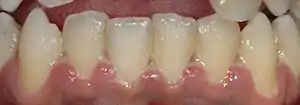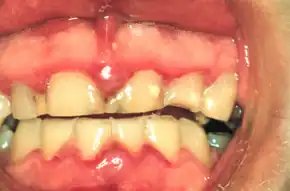Acute necrotizing ulcerative gingivitis
| Acute necrotizing ulcerative gingivitis | |
|---|---|
| Other names: Trench mouth | |
 | |
| A fairly mild presentation of acute necrotizing ulcerative gingivitis at the typical site on the gums of the anterior mandibular teeth. | |
| Specialty | Dentistry |
| Symptoms | Gum pain, bleeding gums, ulceration of the gums between the teeth[1] |
| Complications | Necrotizing ulcerative periodontitis (NUP), cancrum oris[1] |
| Usual onset | Sudden[1] |
| Risk factors | Smoking, poor oral hygiene, malnourished, psychological stress, weak immune system[1] |
| Diagnostic method | Based on symptoms[1] |
| Differential diagnosis | Gingivitis, herpetic gingivostomatitis, infectious mononucleosis, multiforme erythema, pemphigus vulgaris[1] |
| Treatment | Removal of dead tissue, chlorhexidine mouth rinses, antibiotics[1] |
| Frequency | Rare[1] |
Acute necrotizing ulcerative gingivitis (ANUG), also known as trench mouth, is a type of infection of the gums.[1] It results in pain, bleeding gums, and ulceration of the gums between the teeth.[1] Other symptoms may include bad breath, large lymph nodes, and fatigue.[1] Onset is generally sudden.[1] Complications can include necrotizing ulcerative periodontitis (NUP) or cancrum oris.[1]
Risk factors include smoking, poor oral hygiene, being malnourished, psychological stress, and a weak immune system such as in HIV/AIDS.[1] It generally occurs due to gram-negative bacteria of the fusiform and spirochete type.[1] It is not contagious.[1] Diagnosis is usually based on symptoms.[1] It is classified as a necrotizing gum disease.[1]
Treatment is by removal of dead gum tissue, chlorhexidine gluconate mouth rinses, and antibiotics.[1] Often metronidazole by mouth is used.[1] Improving oral hygiene is important to prevent recurrence.[1] With treatment, it usually improves with a few days.[1]
Acute necrotizing ulcerative gingivitis is rare.[1] The condition has been known since the 4th century BCE.[1][2] Modern medical descriptions date from 1778 by John Hunter.[2] The term "trench mouth" arose during World War I as many soldiers developed the disease, due to the poor conditions and extreme stress.[2]
Signs and symptoms

In the early stages some affected people may complain of a feeling of tightness around the teeth.[3] Three signs/symptoms must be present to diagnose this condition:[3]
- Severe gum pain.[4]
- Profuse gum bleeding that requires little or no provocation.[3]
- Interdental papillae are ulcerated with dead tissue.[4] The papillary necrosis of NUG has been described as "punched out".[3]
Other signs and symptoms may be present, but not always.[3]
- Foul breath.
- Bad taste (metallic taste).[4]
Malaise, fever and/or cervical lymph node enlargement are rare (unlike the typical features of herpetic stomatitis).[4] Pain is fairly well localized to the affected areas.[4] Systemic reactions may be more pronounced in children.[3] Cancrum oris (noma) is a very rare complication, usually in debilitated children.[4] Similar features but with more intense pain may be seen in necrotizing periodontitis in HIV/AIDS.[4]
Causes
Necrotizing periodontal disease is caused by a mixed bacterial infection that includes anaerobes such as P. intermedia[5] and Fusobacterium as well as spirochetes, such as Treponema.[4]
ANUG may also be associated with diseases in which the immune system is compromised, including HIV/AIDS.[6] ANUG is an opportunistic infection that occurs on a background of impaired local or systemic host defenses. The predisposing factors for ANUG are smoking, psychological stress, malnutrition, and immunosuppression.
The following zones of infection have been described (superficial to deep): the bacterial zone, the neutrophil rich zone, the necrotic zone and the spirochetal zone.
Diagnosis
Diagnosis is usually clinical.[4] Smear for fusospirochaetal bacteria and leukocytes; blood picture occasionally.[4] The important differentiation is with acute leukemia or herpetic stomatitis.[4]
Classification
Necrotizing gingivitis is part of a spectrum of disease termed necrotizing periodontal diseases. It is the most minor form of this spectrum, with more advanced stages being termed necrotizing periodontitis, necrotizing stomatitis, and the most extreme, cancrum oris. Acute necrotizing ulcerative gingivitis (ANUG) refers to the clinical onset of NUG. The word acute is used because usually the onset is sudden.[3] Other forms of NUG may be chronic or recurrent.
Necrotizing ulcerative periodontitis (NUP) is where the infection leads to attachment loss, and involves only the gingiva, periodontal ligament and alveolar ligament.[3][6][5] Progression of the disease into tissue beyond the mucogingival junction characterizes necrotizing stomatitis.
Treatment
Treatment includes irrigation and debridement of necrotic areas (areas of dead and/or dying gum tissue), oral hygiene instruction and the uses of mouth rinses and pain medication. If there is systemic involvement, then oral antibiotics may be given, such as metronidazole.[4] As these diseases are often associated with systemic medical issues, proper management of the systemic disorders is appropriate.[6]
Prognosis
Untreated, the infection may lead to rapid destruction of the periodontium and can spread, as necrotizing stomatitis or noma, into neighbouring tissues in the cheeks, lips or the bones of the jaw. As stated, the condition can occur and be especially dangerous in people with weakened immune systems. This progression to noma is possible in malnourished susceptible individuals, with severe disfigurement possible.
Epidemiology
In developed countries, this disease occurs mostly in young adults. In developing countries, NUG may occur in children of low socioeconomic status, usually occurring with malnutrition (especially inadequate protein intake) and shortly after the onset of viral infections (e.g. measles).[3]
Predisposing factors include smoking, viral respiratory infections and immune defects, such as in HIV/AIDS. Uncommon, except in lower socioeconomic classes, this typically affects adolescents and young adults, especially in institutions, armed forces, etc., or people with HIV/AIDS.[4] The disease has occurred in epidemic-like patterns, but it is not contagious.[3]
History
Necrotizing ulcerative gingivitis has been observed for centuries. Xenophon observes sore mouth and foul smelling breath in Greek soldiers in the 4th century BC. Hunter describes the clinical features of ANUG in 1778, differentiating it from scurvy (avitaminosis C) and chronic periodontitis. Jean Hyacinthe Vincent, a French physician working at the Paris Pasteur Institute describes a fusospirochetal infection of the pharynx and palatine tonsils, causing "ulcero-membranous pharyngitis and tonsillitis",[7] which later became known as Vincent's angina. Later in 1904, Vincent describes the same pathogenic organisms in "ulceronecrotic gingivitis". Vincent's angina is sometimes confused with NUG, however the former is tonsillitis and pharyngitis, and the latter involves the gums, and usually the two conditions occur in isolation from each other.
The term trench mouth evolved because the disease was observed in front line soldiers during World War I, thought to be a result at least partly because of extreme psychologic stress they were exposed to.[3] The same condition was appearing in civilians during periods of bombing raids, who were away from the front line, and who had relatively good diets during wartime due to rationing, so it is assumed that psychologic stress was the significant causative factor. It has also been associated with high tobacco use in the army.
Many other historical names for this condition (and Vincent's angina) have occurred, including: "acute membranous gingivitis", "fusospirillary gingivitis", " fusospirillosis", "fusospirochetal gingivitis", "phagedenic gingivitis", "Vincent stomatitis", "Vincent gingivitis", and "Vincent infection".[8]
In the late 1980s-early 1990s, it was originally thought that some necrotizing periodontal diseases seen in severely affected AIDS patients were strictly a sequela of HIV, and it was even called HIV-associated periodontitis.[9] It is now understood that its association with HIV/AIDS was due to the immunocompromised status of such patients; it also occurs with higher prevalence in association with other diseases in which the immune system is compromised.[6]
See also
References
- 1 2 3 4 5 6 7 8 9 10 11 12 13 14 15 16 17 18 19 20 21 22 23 24 Aaron, SL; DeBlois, KW (January 2022). "Acute Necrotizing Ulcerative Gingivitis". PMID 32965914.
{{cite journal}}: Cite journal requires|journal=(help) - 1 2 3 Taylor, Robert B. (23 January 2017). The Amazing Language of Medicine: Understanding Medical Terms and Their Backstories. Springer. p. 90. ISBN 978-3-319-50328-8. Archived from the original on 28 April 2022. Retrieved 28 April 2022.
- 1 2 3 4 5 6 7 8 9 10 11 Karring, edited by Jan Lindhe, Niklaus P. Lang, Thorkild (2008). Clinical periodontology and implant dentistry (5th ed.). Oxford: Blackwell Munksgaard. pp. 413, 459. ISBN 9781405160995.
- 1 2 3 4 5 6 7 8 9 10 11 12 13 Scully, Crispian (2008). Oral and maxillofacial medicine : the basis of diagnosis and treatment (2nd ed.). Edinburgh: Churchill Livingstone. pp. 101, 347. ISBN 9780443068188.
- 1 2 American Academy of Periodontology (1999). "Consensus report: Necrotizing Periodontal Diseases". Ann. Periodontol. 4 (1): 78. doi:10.1902/annals.1999.4.1.78.
- 1 2 3 4 American Academy of Periodontology (May 2000). "Parameter on acute periodontal diseases. American Academy of Periodontology" (PDF). J. Periodontol. 71 (5 Suppl): 863–6. doi:10.1902/jop.2000.71.5-S.863. PMID 10875694. Archived from the original (PDF) on 2010-11-28.
- ↑ Taylor, FE; McKinstry, WH (1917). "The Relation of Peri-dental Gingivitis to Vincent's Angina". Proceedings of the Royal Society of Medicine. 10 (Laryngol Sect): 43–8. PMC 2017821. PMID 19979715.
- ↑ "Definition of Vincent angina". Medterms.com. 2001-09-13. Archived from the original on 2011-06-05. Retrieved 2010-02-13.
- ↑ NYS Department of Health AIDS Institute. "Clinical Manifestations and Management of HIV-Related Periodontal Disease". Oral Health Care for People with HIV Infection: HIV Clinical Guidelines. p. 31.
External links
| Classification | |
|---|---|
| External resources |